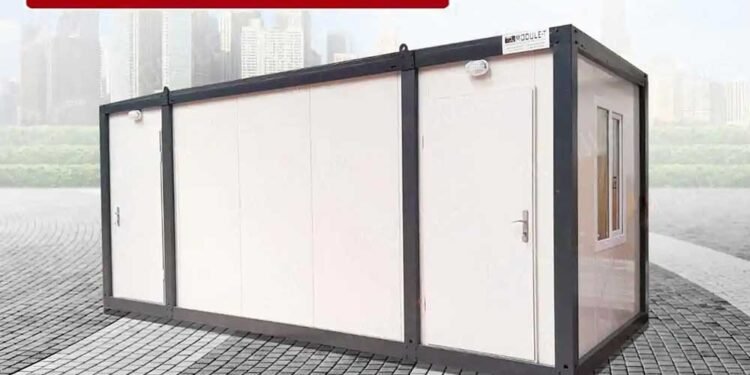Utilizing
resources in the best way possible results in actualizing your end goal with minimal waste, time, and effort. Efficiency is the core of any successful operation, whether running a for-profit or non-profit organization. Your work environment significantly impacts efficiency, so organizations strive to develop the most practical and functional offices. Container offices continue to help unlock efficiency in today’s rapidly evolving workplace characterized by remote operations.
Office containers offer flexibility, portability, and adaptability to maintain continuity even in on-the-move operations. Besides unlocking office efficiency, the office container approach also saves resources by keeping the containers out of dumpsites and prolonging their useful lifetime, which is eco-friendly and sustainable in the long run.
Unlocking Efficiency: How Office Containers Streamline Workspace Solutions
Utilizing resources in the best way possible results in actualizing your end goal with minimal waste, time, and effort. Efficiency is the core of any successful operation, whether running a for-profit or non-profit organization. Your work environment significantly impacts efficiency, so organizations strive to develop the most practical and functional offices. Container offices continue to help unlock efficiency in today’s rapidly evolving workplace characterized by remote operations.
Office containers offer flexibility, portability, and adaptability to maintain continuity even in on-the-move operations. Besides unlocking office efficiency, the office container approach also saves resources by keeping the containers out of dumpsites and prolonging their useful lifetime, which is eco-friendly and sustainable in the long run.
How Much Do Office Containers Increase Employee Productivity?
Employee productivity significantly relies on the work environment and access to relevant resources, which an office facilitates. Among the main highlights of the office container enhancing employee productivity is resource accessibility. This mainly considers the increasing on-the-move needs as remote working continues to become the norm. Modular office containers’ portability and adaptability mean employees can quickly access all the resources they need regardless of environmental constraints. For instance, disaster response teams can move the office container to the affected region and access a convenient and secure workspace. The office containers can also serve as a shelter, storage unit, and in disaster scenarios, serve as a medical facility. This increases productivity considering the saved time and effectiveness to effectively navigate the situation with the needed resources within reach, even in complex environments.
Modular office container flexibility facilitates customizations that easily match the various operations’ needs. Whether it is an open layout to enable collaboration or closed units for privacy and security, office containers can be designed for specific uses. Since the office container costs a fraction of what a traditional structure requires, it can cost-effectively be personalized to offer a sense of ownership and comfort for the employees’ unique function, which boosts motivation and increases productivity. This promotes privacy and security needed in sensitive areas, not to mention the noise and distraction minimization that improves concentration and productivity. The separate dedicated workspaces personalized with aesthetics designed to improve mood and productivity translate to efficient operations, contributions organizations realize without breaking the bank since office containers do not cost a fortune compared to traditional constructions.
The Flexibility of Office Containers & Fast Setup Times
Office containers are versatile; ideal for short- and long-term projects. Their flexibility facilitates innovative configurations to ensure they are equipped with the necessary amenities per projects’ requirements. The office can include storage spaces, conference rooms, restrooms, and break areas. They can also be customized with technology tools, insulated per environmental considerations, and equipped with security measures. The flexibility means the modular office container can be designed as a standalone workspace deployable even in the most remote areas where constructing traditional buildings is unlikely or overly demanding. Such flexibility is essential in the modern arena, especially in research, mining, construction, and oil and gas exploration projects. The flexibility means employees can maintain continuity and a high productivity level since they access comfortable and functional workspace tailored to the operation’s needs.
Fast setup time is the other notable office container advantage improving employee efficiency and productivity. The office containers’ ability to accommodate the changing space requirements facilitates scalability that’s hardly achievable with traditional permanent structures. The setup does not require extensive measures like knocking down walls to customize the office to match the growing space needs. The modular container offices can quickly be expanded or downsized to meet your requirements. You can add or remove individual units with minimal downtime since the setup, especially with prefabricated modular container offices, consumes a portion of the time it would take to construct a permanent office. Such fast setup times and lower costs facilitate the scalability needed in anticipation of future growth or fluctuations in office space needs. This allows an organization to stay on top of its workspace needs and provide employees with the work environment to manage their functions efficiently.
Easy Installation and Portability of Office Containers
Brick-and-mortar office construction takes time, considerable skilled labor, and resources. Office containers eliminate most of such concerns, facilitating quicker setup and installation. Modular designs further make the office container easier to install. The architectural designs account for the flexibility and adaptability needed in various settings. This means the office containers can quickly be dismantled, transported to the set destination, and reassembled. The installation process is more straightforward since it does not necessitate extensive ground preparation. The office container can be installed directly on the ground, which is ideal for short-term projects. Suppose the office is needed for more demanding projects expected to take longer. In that case, it can be anchored with a foundation that doesn’t take as much time to prepare and can be directly connected to the required utilities like water and electricity.
The portability of office containers is perhaps the primary benefit that continues to propel its growing popularity. The modular office container is built to be mobile, facilitating relocation and fast setup in different areas. The standardized construction dimensions ensure that the containers can be easily transported by trains, trucks, or ships. The portable office can be relocated and set up in the new project site without costly expenditure or extensive timeframe like it would with traditional constructions. This allows an organization to conveniently manage their remote areas’ needs since the fast transportation and setup facilitate continuity. While short-term projects like trade shows and exhibitions are the biggest winners, office containers’ portability helps organizations of all sizes in the modern workplace characterized by considerable remote operations.
Office containers continue to unlock efficiency in terms of functionality, cost-effectiveness, and resource maximization. The office container approach entails repurposing and fabricating transportation containers to meet office needs. Recycling provides an eco-friendly and sustainable means to provide a functional work environment. Considering their versatility, adaptability, flexibility, and portability, office containers offer notable contributions that facilitate efficient operation regardless of a project’s environment. The model will only continue to gain traction as organizations strive to maintain continuity in the modern landscape, where remote projects continue to dominate, and the demand for a more eco-friendly approach remains the priority.












